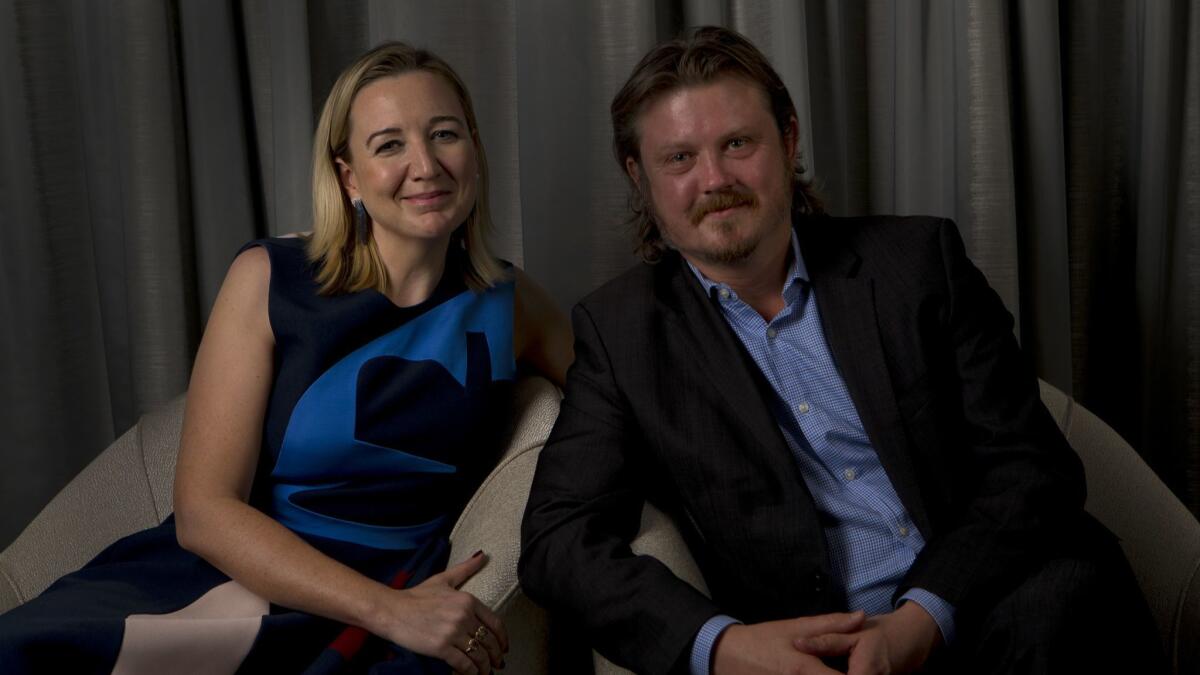Smear campaigns, political savvy and treacherous men: ‘Mary Queen of Scots’ as a mirror to today

- Share via
Long before Beau Willimon created the Netflix political thriller “House of Cards,” he hankered to get one of his plays staged at the tiny Bush Theatre in London run by visionary artistic director Josie Rourke. Introduced by their mutual agent, Rourke recalls, “We clicked.” Years later, Working Title Films producers asked Rourke to helm their long-gestating “Mary Queen of Scots” project after seeing her Donmar Warehouse production of “Les Liaisons Dangereuses.” Rourke enlisted Willimon to write a fresh take, resulting in the recently released royal drama featuring Saoirse Ronan in the title role opposite Margot Robbie’s Queen Elizabeth. Over a recent lunch in Beverly Hills, Rourke (salmon) and Willimon (gnocchi) discussed key ingredients of their 16th-century period piece.
Mary Stuart’s tumultuous life and death have been widely covered before. How did you shape your take on the story?
Willimon: I felt it was important to have one historian to rely on and Josie said the best source would be John Guy’s book, “Queen of Scots: The True Life of Mary Stuart.”
Rourke: John rolled up his sleeves, went into the archive and learned that the story we’ve always been told about Mary is not the real story. Even during Mary’s own lifetime, Queen Elizabeth’s advisor Cecil, played by Guy Pearce in our movie, launched this smear campaign against her.
Willimon: She’s often been portrayed as this reckless, over-emotional youth who got into a political jam because she wasn’t thinking things through. Our movie argues that Mary was a politically savvy operator who knew exactly what she was doing.
After Mary’s been kicked off the throne of Scotland, the queens meet for the first time. How did you go about imagining this encounter?
Willimon: We envisioned a scene that didn’t necessarily happen in the historical record so we asked ourselves: If this meeting had taken place and been kept secret, what would that environment look like?
Rourke: We shot in an English barn made of wattle and daub, an ancient type of English architecture that weaves slats of wood together. I liked the idea that these two crowned heads of Europe would meet in a wash house where you do laundry.
The meeting goes pretty well until Mary calls Elizabeth her inferior. It’s as if she can’t help herself.
Willimon: Imagine the immense reserves of energy and confidence you must construct on a daily basis when people have tried to undermine your legitimacy every step of the way. So even when Mary stares another queen in the eye who is her equal, even in this moment of dire desperation when she needs help from her cousin, Mary can’t let go of this DNA within her that she’s cultivated her entire life. She is the queen.
Rourke: Beau understands like no other how to write proper Shakespearean tragedy. It’s the idea that the essence of a person is the very thing that will bring her down.
FULL COVERAGE: Get the latest on awards season from The Envelope »
Mary’s also brought low by treacherous men, while Elizabeth at one point enters this hallway filled with 100 men and there’s not a single woman in sight.
Rourke: I see that scene and go, “That looks like many board meetings I have been in!” [Laughter]. Early in my career, you’d walk into these rooms at the Royal Shakespeare Company and there’d be nobody but men in there. You have to psych yourself up to walk out into that sea of men, and that’s one of the things Beau captured so beautifully in his script. So often in costume dramas, people put on fancy clothes and it can feel like you’re just being seen for beauty or allure or prettiness. But in our film, Queen Mary and Queen Elizabeth are putting on a kind of armor when they get dressed. It’s a political act.
Willimon: Modern counterparts are happening as we speak. Yesterday somebody on Twitter criticized [then] Congresswoman-elect Alexandria Ocasio-Cortez because of her coat and shoes. Mary and Elizabeth faced a similar kind of scrutiny, except for them it was a matter of life and death.
Rourke: There’s always been this obsession with how women political figures present themselves and what they wear. In rehearsal with Saoirse and Margot, we looked at the history of how female politicians have been portrayed. You can read entire articles about Theresa May’s shoe collection.

More to Read
From the Oscars to the Emmys.
Get the Envelope newsletter for exclusive awards season coverage, behind-the-scenes stories from the Envelope podcast and columnist Glenn Whipp’s must-read analysis.
You may occasionally receive promotional content from the Los Angeles Times.










